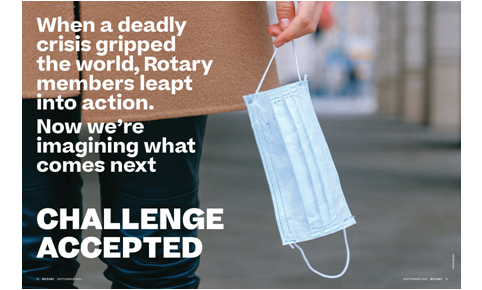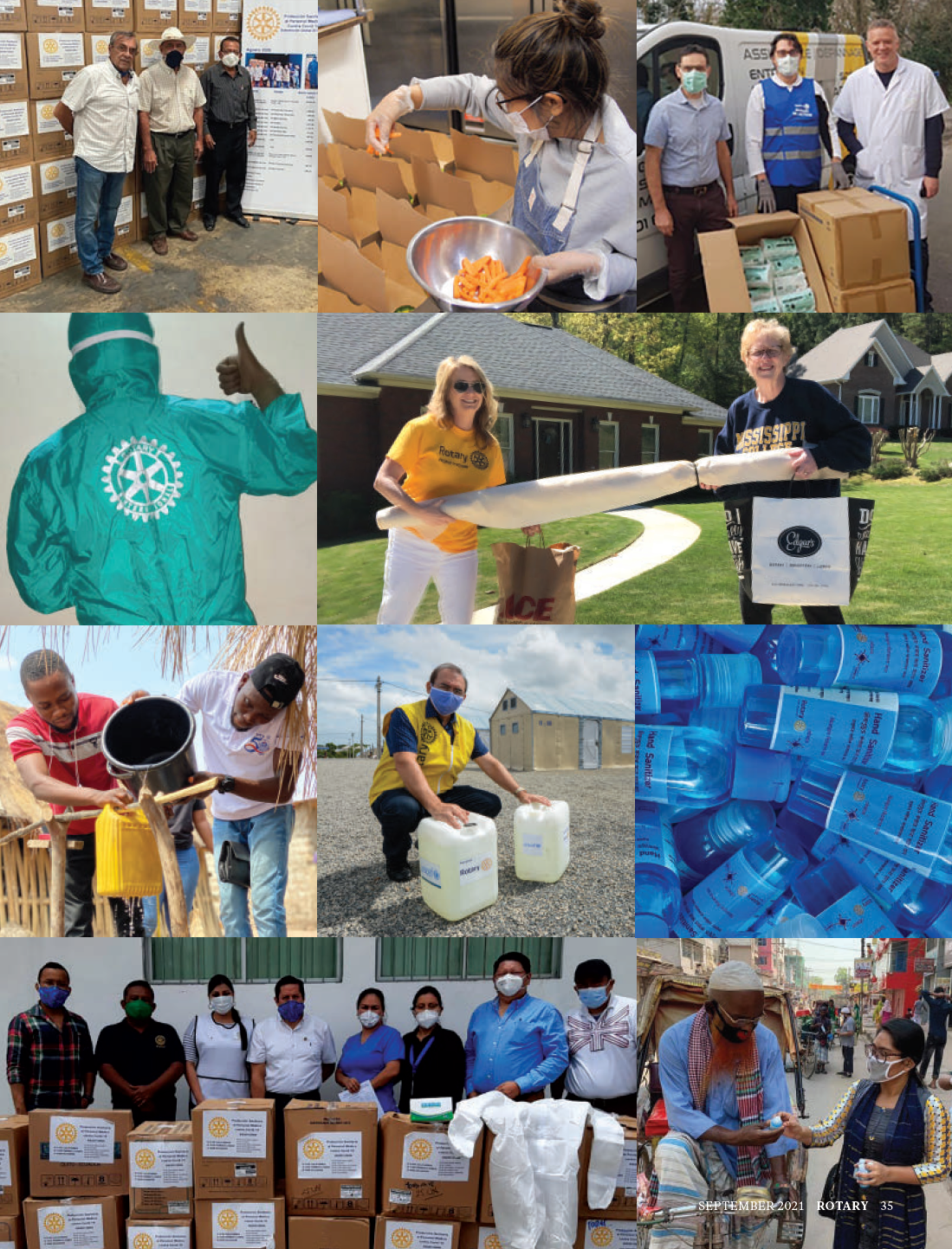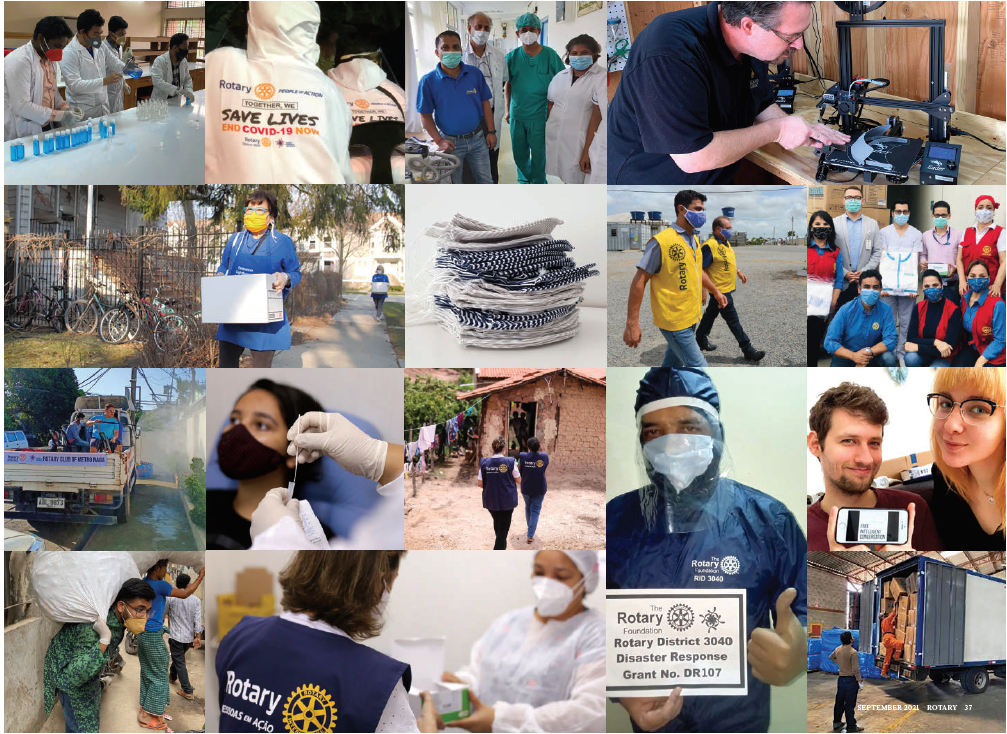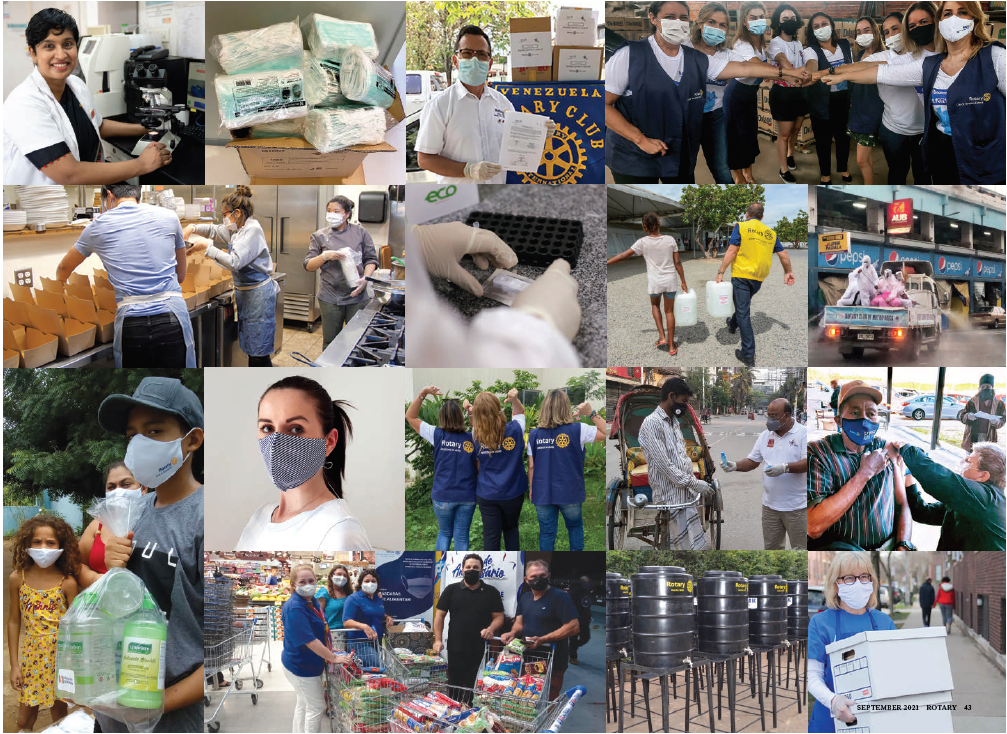
Eighteen months ago, the world ground to a halt, and for one brief moment, Rotary paused along with it. In March 2020, the magazine stopped the presses on its May issue in order to include a newly written message from 2019-20 RI President Mark Maloney.
“Throughout early March, the news about COVID-19 became increasingly serious throughout the world,”
he explained. “We asked all Rotary districts and clubs to curb face-to-face meetings until further notice and to hold virtual meetings instead. Maloney kicked things back into gear: “The world is changing rapidly,” he wrote, “and so must Rotary. Our adaptability and strength will help us navigate this experience.”
he explained. “We asked all Rotary districts and clubs to curb face-to-face meetings until further notice and to hold virtual meetings instead. Maloney kicked things back into gear: “The world is changing rapidly,” he wrote, “and so must Rotary. Our adaptability and strength will help us navigate this experience.”
Rotarians everywhere responded to Maloney’s call to action. In some cases, they had even anticipated it. By the time that May issue landed in mailboxes, many clubs had already shifted to virtual meetings, and members worldwide were providing on-the-ground support for health care workers, communities in need, and the people most susceptible to the pandemic’s reach.
In June 2020, we published our first roundup of COVID-related projects, and in July, 2020-21 RI President Holger Knaack noted in his first magazine message that “every great challenge is an opportunity for renewal and growth.” In that same issue, we showed how Rotary and its partners in the Global Polio Eradication Initiative had been drawing on their experience to respond to the pandemic, and in August, we told personal stories from 10 frontline workers around the world — nine Rotarians and one Rotaractor who, despite the grave risk to their own health, stepped forward to offer assistance, comfort, and inspiration.
Since then, we’ve continued to cover the nimbleand creative ways clubs have found to respond to the pandemic, much of that work funded through grants from The Rotary Foundation: As of June, more than $27 million in global grant funding had gone directly to Rotary’s COVID-19 response, on top of nearly $8 million in disaster response funding.
Rotary has adapted, just as Maloney and Knaack assured us we could. And despite the pandemic, Rotarians and Rotaractors have continued to make a difference: We celebrated the end of wild poliovirus in Africa. We adopted a new area of focus, the environment. And earlier this year, we welcomed the inaugural cohort of peace fellows to the first Rotary Peace Center in Africa.
In this article, we take stock of the last 18 months and look ahead to what’s next. You will find examples of the ingenuity, creativity, and resilience that Rotary members have displayed from the start. You will hear from a Rotarian epidemiologist and COVID-19 task force member about Rotary’s role in the pandemic response. You will read about how clubs have embraced change — and learn how virtual connectivity could open the door for more people to get involved in Rotary’s mission.
In the past year, because of everything we’ve been through together, each of us has changed, taking on new challenges and learning new skills. Rotary has changed as well, and more change is surely coming. But as RI President Shekhar Mehta reminded us two months ago in his first Rotary message to members: “No challenge is too big for Rotarians.”

Pandemic projects
Members of Rotary served as volunteers, as professionals, and as role models, advocating for vaccination and encouraging others by their own example. Clubs provided masks and other PPE, testing kits, educational materials, diagnostic equipment, intubation tubes, ventilators, hand sanitizer, personal hygiene items, and other essentials such as food and water. They provided aid to refugees and people who were homeless, as well as vocational training to assist people looking for work. Through online seminars, social media updates, and other outlets, clubs also served as a reliable source of information about vaccines and other pandemic related topics.
Members of Rotary served as volunteers, as professionals, and as role models, advocating for vaccination and encouraging others by their own example. Clubs provided masks and other PPE, testing kits, educational materials, diagnostic equipment, intubation tubes, ventilators, hand sanitizer, personal hygiene items, and other essentials such as food and water. They provided aid to refugees and people who were homeless, as well as vocational training to assist people looking for work. Through online seminars, social media updates, and other outlets, clubs also served as a reliable source of information about vaccines and other pandemic related topics.

#RotaryResponds
Rotarians, Rotaractors, and Interactors all stepped up to help during the pandemic. In the photos on these and preceding pages, you can see some of the people who volunteered and the projects they organized. They include members of the Interact Club of Sonrise Christian High, Ghana, and the Rotaract clubs of Ho, Ghana; University of Health and Allied Sciences, Ghana; and Warszawa Frydryk Chopin, Poland. Also represented here are the Rotary clubs of North Jefferson and Gardendale, Alabama; Boa Vista-Caçari, Teresina-Fátima, and Vargem Grande Paulista-Conecta, Brazil; Guayaquil Norte and Tsachila de Santo Domingo, Ecuador; Meaux, France; Evanston Lighthouse, Illinois; Madras Next Gen, India; Trenton, North Carolina; Metro Naga, Philippines; Singapore; Plainview, Texas; and Valera, Venezuela; as well as members of Rotary in districts 3040 (India), 3281 (Bangladesh), and 9212 (Kenya).
Rotarians, Rotaractors, and Interactors all stepped up to help during the pandemic. In the photos on these and preceding pages, you can see some of the people who volunteered and the projects they organized. They include members of the Interact Club of Sonrise Christian High, Ghana, and the Rotaract clubs of Ho, Ghana; University of Health and Allied Sciences, Ghana; and Warszawa Frydryk Chopin, Poland. Also represented here are the Rotary clubs of North Jefferson and Gardendale, Alabama; Boa Vista-Caçari, Teresina-Fátima, and Vargem Grande Paulista-Conecta, Brazil; Guayaquil Norte and Tsachila de Santo Domingo, Ecuador; Meaux, France; Evanston Lighthouse, Illinois; Madras Next Gen, India; Trenton, North Carolina; Metro Naga, Philippines; Singapore; Plainview, Texas; and Valera, Venezuela; as well as members of Rotary in districts 3040 (India), 3281 (Bangladesh), and 9212 (Kenya).

THE SCIENCE OF SAVING LIVES
Ann Marie Kimball knows about pandemics — in fact, she wrote a book about them. An epidemiologist and physician, Kimball lectured on emerging infections at the University of Washington, worked with the White House to set up the Asia-Pacific Economic Cooperation (APEC) Emerging Infections Network, earned Fulbright and Guggenheim awards for her work on global trade and emerging infections, designed a global disease surveillance strategy for the Bill & Melinda Gates Foundation, and authored Risky Trade: Infectious Disease in the Era of Global Trade.
Kimball was introduced to Rotary not by a member, but by vaccines. “Part of my job when I first started working in West Africa was to ensure that the vaccines arriving at airports moved from the tarmac into storage safely,” she says. “I started seeing these crates with the Rotary wheel, and I didn’t know what Rotary was. So I resolved to find out.”
Now a member of the Rotary Club of Bainbridge Island, Washington, Kimball also serves on Rotary’s COVID-19 task force, which is exploring the organization’s role in responding to the pandemic. The task force is encouraging actions such as mobilizing clubs and promoting vaccinations.
Kimball spoke with Rotary senior staff writer Diana Schoberg in May about the pandemic and Rotary’s work.
What is your role on Rotary’s COVID-19 task force?
My role is primarily technical: to advise the members on the global state of the pandemic. Unfortunately, worldwide, we still have a very active pandemic. We’ve lost more than 3.5 million people across the globe, and we believe that’s an undercount. The other thing we’re tracking very closely is vaccine equity and access. Despite 1.4 billion doses [as of 13 May] being administered worldwide, fewer than 1 percent of those are in sub- Saharan Africa. So we’re seeing real inequality. I will advise the task force on situation awareness and policy options as we move forward.
How is Rotary well-positioned to address COVID-19? What are our strengths and how can we best put them to use?
You’re seeing a lot of great work by Rotarians across the board, and it’s very heartening. There’s a lot of altruism and community spirit. To a certain extent, we hear all of the bad news and we don’t hear enough of the good news. And Rotary is in the business of creating good news.
Rotary is a very powerful partner in COVID-19 response because our organization is multisectoral; it’s not confined to the health sector. And it also brings a strong level of volunteerism. Our response is both diverse and tailored locally, which makes it even more valuable.
You’ve written that Rotary can bridge the gap between science and values in the COVID-19 response. What did you mean by that?
Altruism is very much a core value of Rotary. So in speaking about why an individual should get a vaccination, you can cite the figures, that it’s 94 percent protective or it’s 80 percent protective. But the conversations that I’m hearing in my community, for example, are about what is your responsibility to get vaccinated to help protect the rest of your community and the people you interact with. And that’s what I think Rotary can really bring forward.
Community education is a way of providing the science and awareness of the situation to an individual community. It also involves reaching out to other civic organizations and government entities to coordinate and collaborate.
So many people have died, and so we have a mission of the heart, too. Many Rotary clubs have committees that reach out to support bereaved people and people who are ill. That’s another piece of it, in terms of values.
What might combating misinformation look like for a Rotary club? And how will that vary by region?
It depends on what the rumors are. I’ve tried to keep my ear to the ground in my own community, and it just means listening and then having respectful conversations. People who believe misinformation aren’t stupid; they’re just misinformed. Bringing credible information forward in a respectful manner can often make the difference.
We can tell them, from our experience with polio and our long experience with childhood vaccinations, that these vaccines are safe and they’re highly effective, and that we know vaccines work.
What’s the difference between dialogue and persuasion when it comes to vaccine hesitancy?
When I first joined the task force, I recommended a book to the other members titled Stuck: How Vaccine Rumors Start — and Why They Don’t Go Away, by Heidi Larson. It draws from years of research on vaccine hesitancy. The takeaway is that you need to listen, and then there has to be an interchange. You may or may not be successful at persuasion, but really listening is very, very important. I was amazed at some of the rumors going around that have a slim basis in some piece of fact but have been entirely distorted and misinterpreted.
It’s really a dialogue. Rotary is nonpolitical. We have a vast array of Rotarians with a vast array of political beliefs, and we don’t do politics in our clubs. And that is very important for Rotary’s credibility.
As the vaccine rollout continues, how concerned should we be about outbreaks of variants?
If I had a crystal ball, I could tell you. There are a lot of questions about variants. Variants will always evolve, although the coronavirus mutates more slowly than influenza, and more slowly by far than HIV. But it is an RNA virus [which mutates more rapidly than a DNA virus]. So the more it transmits, the more opportunities there are for variants to occur. Vaccination remains our only tool, and if you were able to vaccinate everyone successfully, you could really tamp down transmission and variants. Generally, viruses mutate toward more infectiousness, but they don’t mutate toward more lethality for their host — that’s a very broad generalization. The virus wants you walking around and passing it on to other people.
If the coronavirus doesn’t evolve as fast as influenza, does that mean that if enough people get vaccinated, there will be fewer variants, and we won’t have to get a shot every year? Or am I asking you something that we just don’t know yet?
You’re asking something we just don’t know yet. The strategy is to vaccinate as much as we can and cut down the transmission, and that should cut down on the variants. But you have to remember that influenza is totally different than the coronavirus, except that they’re both RNA viruses. We thought the coronavirus was going to be seasonal because it tended to have peaks that correlated with winter, but now we’re seeing that it also has peaks correlating with summer. So in that sense, it’s not exactly like the pattern of transmission of influenza. Influenza shifts and drifts on an annual basis, and flu vaccines are composed to match what strain is circulating. And that may eventually become what we see with the coronavirus. But because it’s a new virus, its transmission patterns related to seasonality and to other dynamic forces are not really clear. We don’t know how long a person’s immunity from the shot will last.
Can the strategies that Rotarians have used with polio be applied to COVID-19?
There are experiences and infrastructure that will be helpful: the emergency operations centers, for example, in Nigeria. And also the cold chain logistics and management of the shipment of vaccines, and the vaccination campaigns and the messaging — although the message is different, and it’s a different age group.
What Rotary has done with the Global Polio Eradication Initiative has been absolutely phenomenal. With our 36,000 clubs, we’ve mobilized populations and community leaders all over the world. Rotarians can work fast and know how to get resources where they are needed most.
How else can Rotary clubs help with COVID-19 vaccinations?
Clubs are promoting vaccines through publicity and advocacy, and Rotary members who have a medical background are helping with the actual shot administration. We have great experience in logistics, and our members are helping with traffic and sign-up and reception at vaccination sites, depending on the club. It’s been very hands-on for Rotarians.
Is there a model for equitable distribution, or is that something we’ll need to invent? If you had to start from scratch, what would that look like?
The thinking behind the rollout in the United States primarily came from the National Academy of Medicine. Their recommendation was focused on who had the greatest morbidity and mortality from the disease.
So first you have health care workers, because they’re continuously at risk and your health care system will break down if you cannot protect them. And then there was a large discussion about the disproportionate risk for communities of color and public-facing workers, especially wage workers, and for the elderly. They looked at the burden of disease and used that to form a decision on what equitable distribution would look like. That would be a little bit different for every society.
We know what we don’t mean when we talk about equitable. We don’t mean that vaccines only go to the wealthier class that can pay for it. Or to important politicians who happen to have access to it because they jumped the line. We’ve seen what inequitable distribution can look like.
Is there a vision for equitable distribution where we’d look globally at the burden of disease?
I think our information basis is pretty imperfect. But focusing on countries that have high transmission would make strategic sense. The barriers to doing that have been remarkable. There has been a lot of talk about some countries that have three to five times the number of doses reserved as their population. And that’s the process that COVAX [a global public-private partnership to secure and distribute COVID-19 vaccines] is trying to orchestrate more equitably to ensure vaccine access for lowand lower middle-income countries.
Where will Rotary fit into the long-term recovery from COVID-19 — things like education, mental health, and other needs that might come after the crisis part is over?
That’s exactly where Rotary’s impact could be the strongest. But it will be different in each place. I certainly see economic recovery as part of what we will be addressing. There are some other areas as well. In February, the United Nations Security Council called for a global ceasefire in order to allow for vaccinations. I see Rotary as being part of that peace effort. In the environmental arena, we know that deforestation and the wildlife trade have led to the emergence of these kinds of pathogens, and Rotary can be involved there as well. If you look at our areas of focus, you can’t find one that hasn’t been impacted by this pandemic.
Did you foresee a health crisis like COVID-19 coming? And did the world react the way that you thought it would?
Everyone knew that a respiratory pathogen could be dangerous. No one had planned for complete science denialism in leadership, which we have seen [in some countries]. I have colleagues who had worked very closely on the pandemic plans that had been in place, and that playbook was thrown out. No one foresaw that. Everyone assumed that if you have all of these plans and you have a pretty good idea of what you need to do, you’ll do it. We need to be a lot more conscious of the political economy than we have been as a scientific group.
I think the big lesson we have learned is that science-based leadership is critically important. You need to have the very top of your government supporting the very best measures that society can take to protect itself. That has to be really clear and it has to be said many, many times.
FIVE WAYS TO HELP STOP COVID-19 IN YOUR COMMUNITY
1. Educate people on the importance of vaccination
As of the last week of June, only 1 percent of Nigeria’s population had received at least one dose of a COVID-19 vaccine; the country has struggled with a lack of supply, receiving its first 4 million doses through the COVAX vaccine-sharing program in March. In the meantime, Rotary members in the country are using connections they have made through their polio eradication work to advocate among political leaders, health care workers, the media, and traditional and religious leaders for the importance of COVID-19 vaccinations. They are reaching the general population through informational campaigns on social media, television, and radio, as well as public service announcements broadcast in public squares.
2. Advocate for fair and equal vaccine distribution
The Rotary Club of Demerara, Guyana, has been conducting medical missions in remote parts of the country for decades, which has given members firsthand knowledge of the needs of the communities in those areas. In March, partnering with the country’s Ministry of Health and its Civil Defence Commission, club members traveled by boat to deliver COVID-19 vaccines to the Indigenous villages of Muritaro and Malali. Traditional leaders were among those receiving the vaccines, setting an example for their communities. “Our linkage to these communities and history with our polio efforts gave residents confidence that Rotary wouldn’t leave them behind when COVID-19 vaccines became available,” said club member Lancelot Khan.
3. Address vaccine hesitancy by sharing accurate, fact-based information
Singapore has been steadily vaccinating its population, but significant pockets of people remain hesitant to take the vaccine. The Rotary Club of Singapore worked with the National University of Singapore’s Saw Swee Hock School of Public Health to launch a public health ambassador program in June. In addition to organizing a webinar to answer questions from the public, the school put on a workshop directed at Interactors, Rotaractors, and Rotarians to equip them with the knowledge and skills to dispel myths and educate communities about vaccine safety.
4. Encourage mask wearing and proper hygiene practices
With limited vaccines available, Pakistan faced a third wave of COVID-19 cases this spring. The Rotary-supported polio resource center in Bannu is using its expertise to educate the community about hand washing and other precautionary measures against infection. More than 25 women attended a session in May led by health care workers.
5. Support health agencies’ vaccine distribution efforts
Rotary members in District 2060 (Italy) became critical government partners in getting vaccination sites up and running earlier this year. Within a week of an initial call for volunteers in January, more than 150 Rotarians and Rotaractors stepped forward, including doctors, nurses, paramedics, lawyers, and a notary to help with paperwork. Impressed, the medical authorities in Verona put the district in charge of all volunteer activities related to COVID-19 vaccination in the region, including scheduling patients, assigning shifts, and reporting data. By the end of May, more than 700 volunteers had participated, and more than 300,000 people in the region were vaccinated.